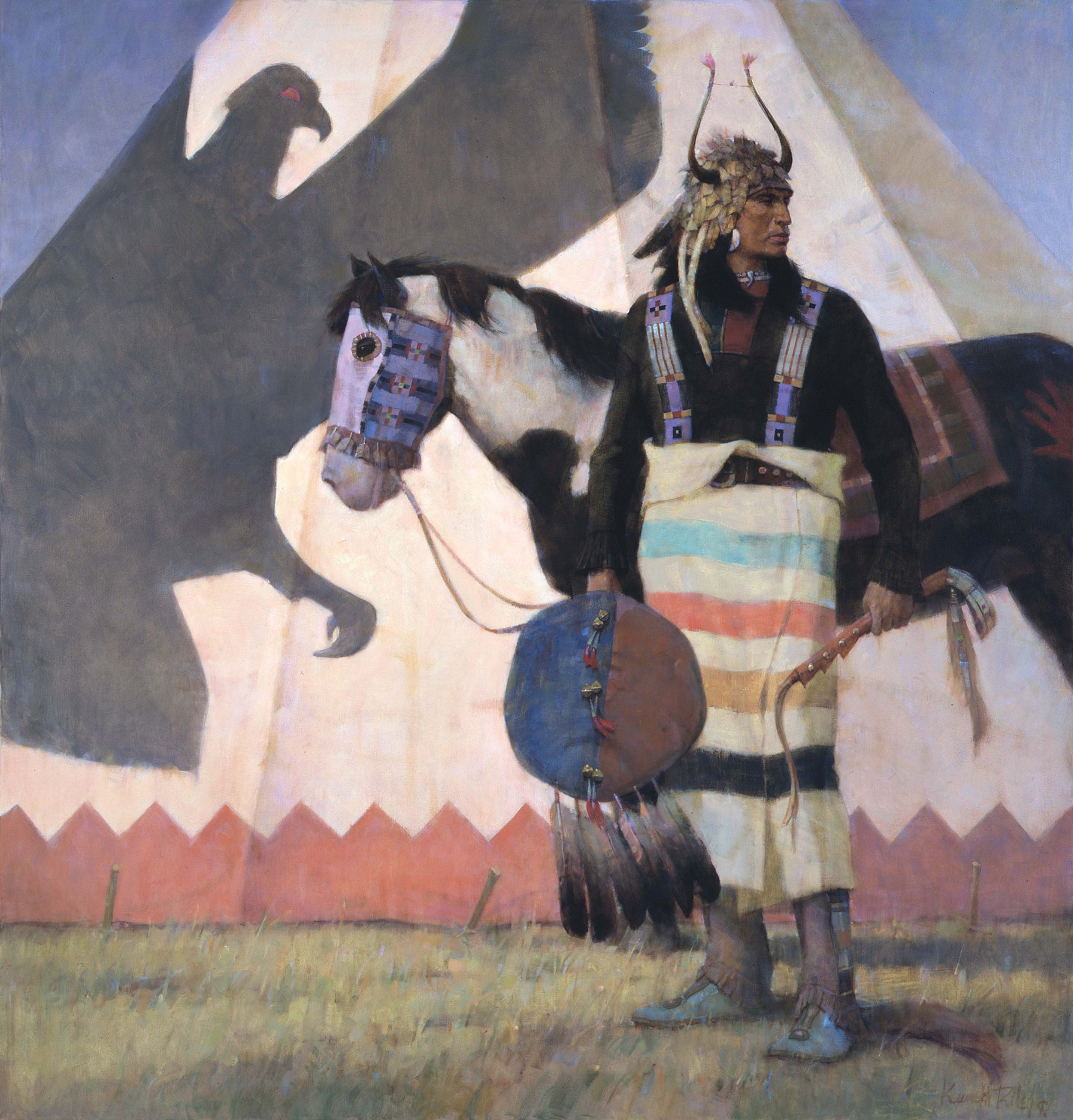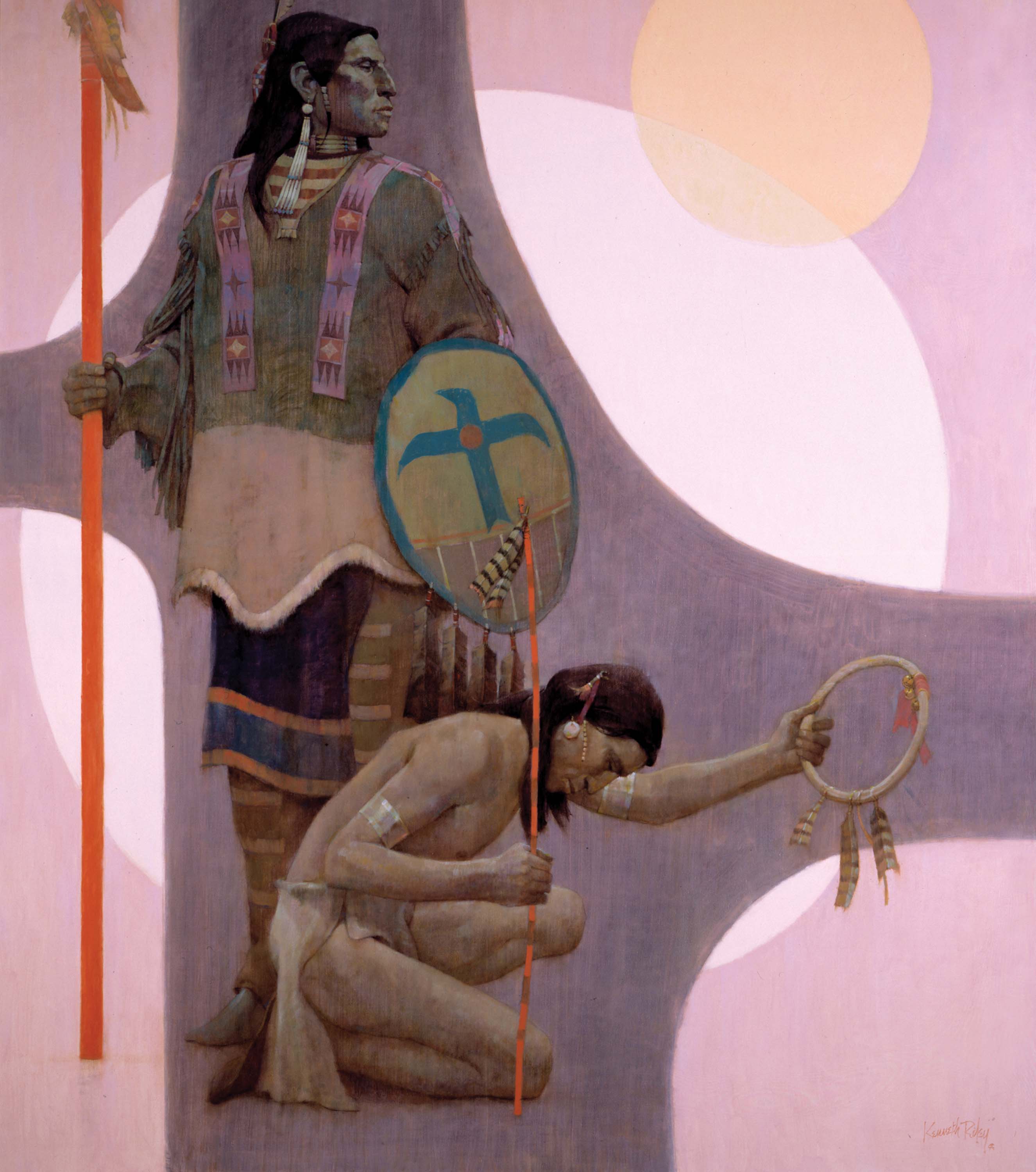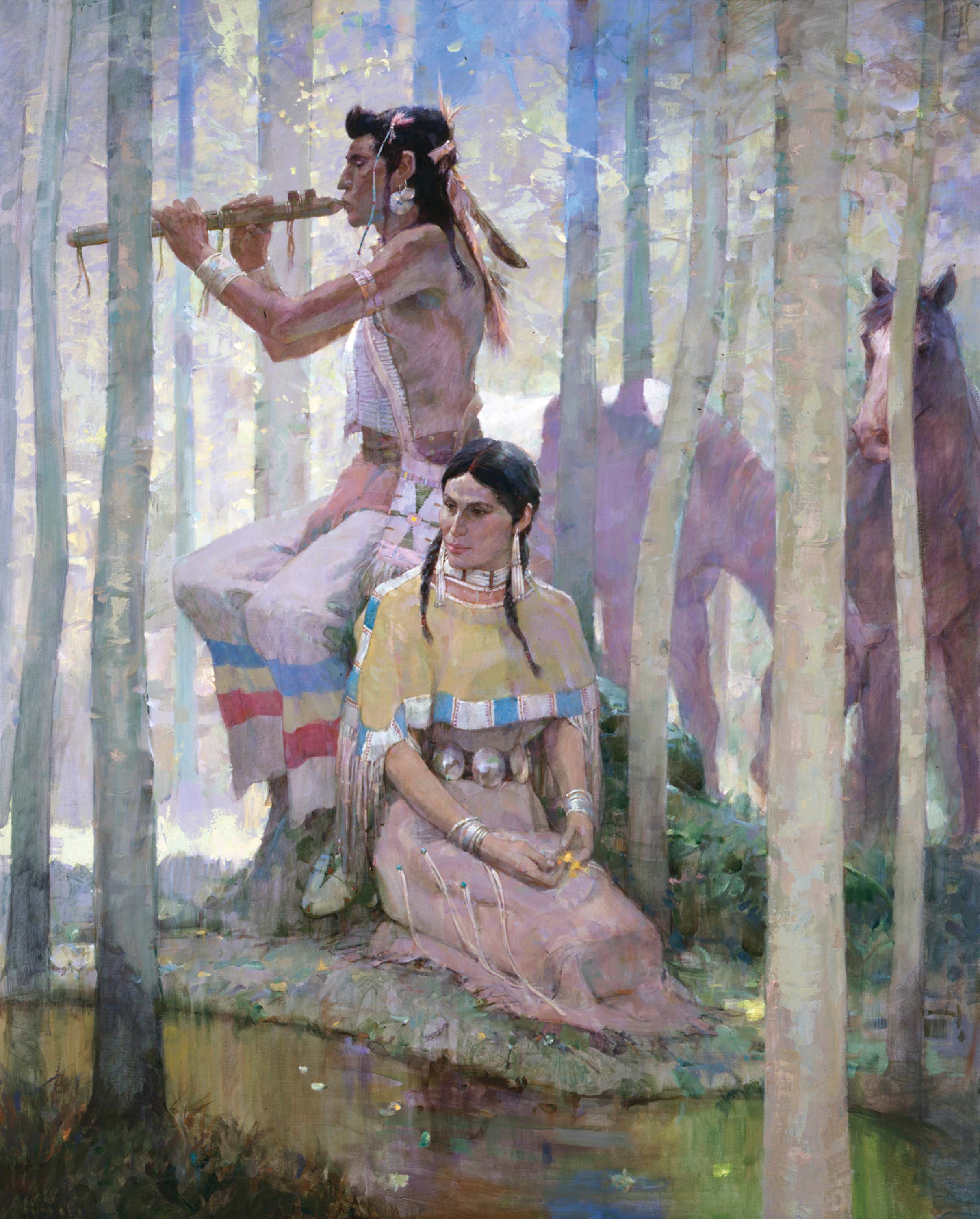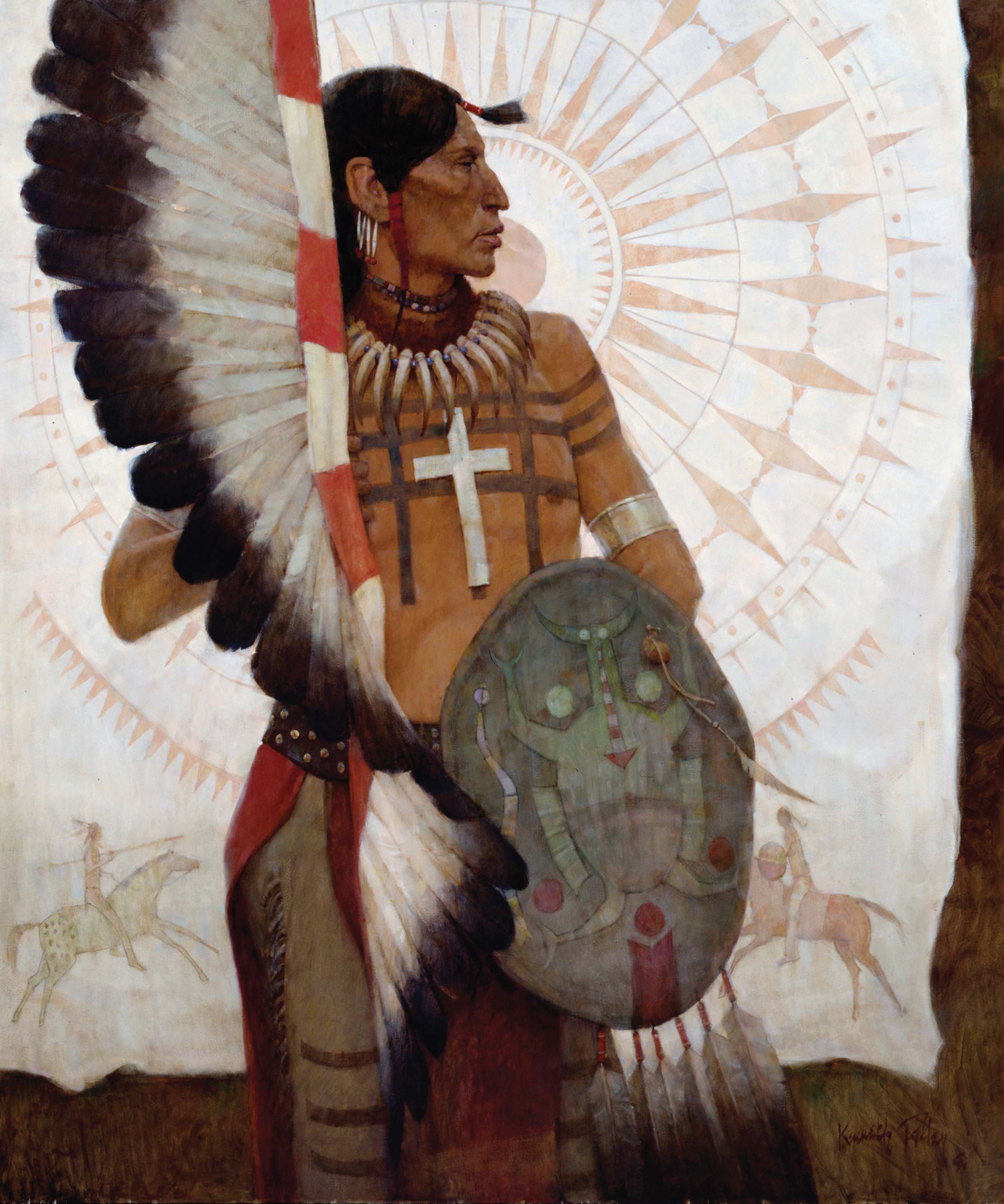
01 Dec The Painting Life of Riley
When it comes to assessing a painter’s legacy, integrity of work and solid investment value, there are some critics adamant in the belief that pedigrees matter. Here is a lineage that only a single man in American fine art can claim: Kenneth Pauling Riley is the last surviving student of the great painter-teacher Harvey Dunn [1884–1952].
While this anecdote alone is intriguing — considering that Dunn himself was a prized pupil of the legendary Howard Pyle [1853 –1911] — of greater profundity is that Riley received direct, simultaneous instruction in painting not only from Dunn, but also from Frank Vincent DuMond [1865–1951], and just a few years earlier in his native heartland, Riley was given lessons in drawing from Thomas Hart Benton [1889–1975], the original mentor, astonishingly, of Abstract Expressionist Jackson Pollock.
What makes this mosaic of connectivity relevant, topical even, is that today, as a bright youngish nonagenarian, Riley continues to paint with a command of palette that eludes artists barely a third his age.
Longevity, however, means little unless the beneficiary remains vital. With Riley, there is a sense that none of his days are ever taken for granted. “Ken defies the maxim that artistic ability diminishes steeply with age,” says Bill Rey, co-owner of Claggett/Rey Gallery in Vail. “He’s never undergone the proverbial long, slow fade. He remains committed and capable of making a statement.”
At the 2012 Jackson Hole Art Auction, Riley’s new easel paintings portraying Native American subjects all sold at the upper end of their pre-sale estimates, defying the sluggish economy. In his Colorado gallery, Rey says that whenever new color studies by Riley arrive, they’re typically gone within days. And, as an indication of collector interest in his major studio paintings coming onto the secondary market, Claggett/ Rey recently sold Riley’s Visit of Lewis and Clark for $485,000.
Part of Riley’s mystique is attributed to the airy romantic atmosphere of his works — as if they were conceived in a timeless, ancient past. Another aspect is that Riley hasn’t been especially prolific, Rey says. A third is he no longer exerts a physical presence at shows and other events he used to frequent, albeit with the personality of a soft-spoken introvert.
“Ken has never been a big self promoter, at least not compared to some of his contemporaries,” Rey says. “He still operates under the old-school presumption that the work should speak for itself. And certainly, over many years, it has.”
Riley, who turned 93 in autumn, 2012, gave no indication in a recent conversation that he plans on slowing down. How is this “old school” practitioner who still has contemporary appeal regarded?
California painter Randal Dutra, nearly 40 years his junior, became friends with Riley when a group of young artists — students of Robert Lougheed and Clarence Tillenius — met him at the Okanagan Game Farm in British Columbia. Riley counted Lougheed among his best friends. Besides being colleagues, the two competed together in a badminton league in Connecticut when they were commercial illustrators. Lougheed asked Riley to appear at Okanagan as a guest instructor.
“Ken is one of the last iconoclasts left in Western art,” Dutra says. “His take on Western subject matter is unique and wholly of his own design. He studied with the best: DuMond by day and Dunn by night. Between the two he received a rare education: from DuMond the mechanics and from Dunn the creative working philosophy.”
In our chat, Riley shared vivid recollections of his encounters with those venerated figures. Dunn’s stature, Riley says, preceded him: He, N.C. Wyeth and Frank Schoonover were taught by Pyle at the Brandywine School in Delaware. A testament to Riley’s reverence for Pyle is that among his prized possessions in his home in Montecito, California, is a small pen-and-ink drawing of a swashbuckler that appeared in Howard Pyle’s Book of Pirates in 1921.
Born in Waverly, Missouri, in 1919 and raised in a small Kansas railroad town, Riley did not receive enthusiastic support for his art interests at home. Although his parents subscribed to The Saturday Evening Post, they told him that aspiring to paint covers for a magazine was no way to earn a respectable living.
Riley credits an older bachelorette school teacher named Olive Rees for believing in him when he had no confidence or direction. She entered his work in shows and paid his tuition to attend the Kansas City Art Institute of Missouri, where he met Benton — and it was there that he was encouraged to seek out Dunn.
Maria Riley, Riley’s wife, shares this observation: “I think it’s amazing that a woman like this, unmarried and with no children of her own, would take a young man under her wing and dramatically alter the course of his life for the better. Because of her, Ken was able to pursue and achieve his fullest potential.”
Riley left Kansas and headed for Manhattan. Teaching nights at Grand Central School of Art, Dunn was selective about whom he took on and Riley had to submit a sample of his work. “Dunn was a big man who had an even larger personality. He kept a little office above Grand Central train station,” Riley says. “It was so small he could hardly wedge himself into it. Was it intimidating? You bet it was, but he was actually a gentle giant.”
During one of the first sessions with a live model in a studio class, Dunn stood behind Riley as he painted tightly and meticulously. “He told me to give him my biggest brush and drove it into my tiny palette. The force resulted in my easel being pushed across the floor,” Riley said. “It was humbling, but memorable. His message was to loosen up and not be meek.”
A core element of Dunn’s teaching method was bringing together all the students on Friday nights for tough-love critiques. “A young woman had a painting that she was working on throughout the week,” Riley explained. “He told her, ‘This is a very pretty picture. You’ve got yourself a pretty little house and a pretty little garden and a pretty little picket fence. But what you really need with this picture is a dead cat in the road.’ I’ve often thought how it was a wonderful statement. He believed that art needed to carry force and intensity; otherwise, what’s the point?”
Dunn’s mantra was actually very simple and it still informs Riley: Strive to identify the epic quality of a subject, not the incidental. Any picture that needs a caption is a weak picture. In making a picture, you should excite interest, not educate.
Dunn left Riley’s head spinning, though it was only half of the equation. Mornings and afternoons were spent at the Art Students League in the company of Impressionist DuMond, the teacher of Georgia O’Keeffe, Norman Rockwell and Lougheed. A tactician, DuMond infused in Riley a life- long instinct for thinking about color value that defines his work to this day. “He would set up models under different lighting conditions. Some low keyed. Some high keyed. And
It was the farthest thing from a pretty house surrounded by a neat picket fence. Clutching his drawing pad and responding viscerally to what he observed, Riley summoned the converging wisdom of Dunn and DuMond as he made sketches that later were transformed into studio paintings.
Upon his return, Riley was assigned to Washington D.C. and eventually, after the war, he resettled in Connecticut, taking illustration assignments for ad agencies and publishing companies. His wartime artwork wasn’t forgotten and still delivers a punch 70 years after the fact. It now resides in the Coast Guard permanent collection. Jeffrey Bowdoin, collections manager and Coast Guard historian, told me that Riley is one of the last surviving American combat artists who served in World War II. “We love his work,” Bowdoin says. “Artistically, it’s of superior caliber and really speaks to the mood of the time.”
In Connecticut, the artist hardly lived an easy “life of Riley.” Countless stories, the best of them penned by Walt Reed, have been written about the Golden Age of Illustration and the convergence of Realists/Impressionists gathered along the East Coast.
Deadline pressure forced artists, who managed to hold up under the grind, to work fast and make decisions about how to achieve maximum impact with line, form, design and composition. There wasn’t time to dawdle or procrastinate. Even when an artist produced a work that was remarkable after a few consecutive all-nighters, there loomed the possibility that, upon delivery in New York, a fickle art director might demand changes, some of them so agonizingly petty, as to drive an illustrator crazy.
Riley painted covers for Bantam Books, which led to assignments for The Saturday Evening Post, National Geographic, Reader’s Digest, Life magazine and, later, the Mormon Church. He achieved international fame for a series of serialized magazine stories about Horatio Hornblower penned by C.S. Forester.
He learned to paint anything. Yet he points to a research trip focused on Northern Plains Indian tribes that whetted his interest in the West. With the demise of demand for fine-art illustration brought by the proliferation of color photography and television, Riley and his peers contemplated their next move. A wave resettled in the West. Riley’s transition was made smoother by assignments to produce a series of book covers and a prestigious commission he won from the National Park Service to paint Yellowstone and other crown jewel national parks. By 1972, he had moved to southern Arizona.
In the Sonoran Desert, Riley became part of the “Tucson 7,” an extraordinary clique of former illustrators who began leaving their marks as fine artists painting Western subject matter. Joining him in the fold were Howard Terpning, Harley Brown, Don Crowley, Tom Hill and the late Bob Kuhn and Duane Bryers. They were the core stable of Stuart Johnson’s Settler’s West Gallery.
Riley earned membership in the Cowboy Artists of America and National Academy of Western Artists. He painted cowboy and Old West scenes, but arguably his greatest, most inspired work emanated from his explorations of High Plains tribes (the Mandans who interacted with Lewis and
Clark) and other bands, such as the Apaches, in the desert Southwest. He embarked upon research road trips with Lougheed, John Clymer, Tom Lovell and Donald Teague.
Those sojourns produced many of the masterworks that viewers see most often in public, collections ranging from the White House and U.S. embassies to the Phoenix Art Museum, the Eiteljorg Museum of American Indians and Western Art, the Gilcrease, the Autry and others.
“Ken’s memorializations of the Mandans are the ones with which he is most synonymous,” Rey says. While there were no photographs, he notes, there was a visual record in the form of sketches and paintings made by George Catlin and Karl Bodmer on expeditions they made into the then-untamed frontier during the first half of the 19th century.
Indeed, Riley told me, he is not a literalist and the only painters who could lay claim to being eyewitnesses were Catlin and Bodmer. “They were there. You can’t pretend that you have some ability to go back in time. If you do, then you’re starting out immediately by being a phony,” he said. “All that you can do is apply what you’ve gleaned through on-the-ground research and interpret it using the talent you have as an artist. Let the viewer decide to make of the scene what they will.”
Riley says he experienced the equivalent of “a second wind” in the mid 1990s. In 1995, he met his wife, Maria, a former gallery manager and graphic designer, at an art walk in Scottsdale. A firecracker of a force, she told Riley he had a choice: He could “retire” and embrace senescence or continue painting — doing what he rises every morning to do with passion — because there was no one stopping him, telling him he needed to quit. “She’s been the heart and soul behind my desire to continue painting,” Riley says, pausing in thought. “She saved my life.”
Every Riley painting has a story that informs it. The Black Eagle speaks to Riley’s irrepressibility. The large work depicts a huge eagle in black silhouette over a tipi, with horse and warrior in front. Riley had begun it, from top to bottom, before he went through a complicated back surgery. Afterwards, he was unable to stand on his feet during convalescence.
“But he was determined to finish the piece,” Maria says. “I never saw anything like it. It was like pain to pleasure.” Laying on a rollaway stool, Riley painted from the bottom up and completed it in the middle. His grimaces, the artist’s wife says, eventually turned to smiles of satisfaction.
There are few honors in the genre of Western art Riley hasn’t won. He has emeritus status with the Cowboy Artists of America. In 1995, his oil painting, Sun Dog, earned the coveted Prix de West Purchase Award. The Booth Western Art Museum in Georgia gave him a life-time achievement award. And the Eiteljorg, which has more than a dozen of his major works, has made him a prominent fixture in its collection.
In 2003, Riley was featured in a major 90-work retrospective at the National Cowboy Hall of Fame and Western Heritage Museum in Oklahoma City. In a catalog that accompanied the exhibition, Susan Hallsten McGarry wrote: “Kenneth Riley is a modern-day mythmaker, who, as Joseph Campbell asserts, tells his stories not in words but in pictures.” She noted that, for Riley, there is no intent to tightly steer the viewer through his narratives, even those based on actual historic events. “As Campbell observes, ‘Ask an artist what his picture means and you will not soon ask such a question again. Significant images render insights beyond speech, beyond the kinds of meaning speech defines.’”
Riley has undying praise for Catlin and Bodmer, though critics have noted how their subjects appear somewhat posed, “stiff” one might say, and the narratives prosaically documentarian. With the advantages of modernity, Riley says that he hopes his paintings convey the beauty of native people without objectifying them, bestowing a more human face that gives viewers a deeper appreciation for North American history, not treating aboriginal culture exotically as separate from our own experience.
That’s also why Riley pays tribute to his painter friend Terpning. Together, they’ve shared a fascination with native subjects, but their approaches are markedly different. Gallery owner Jack Morris, who is also a partner in the Scottsdale and Charleston art auctions, has represented Riley since 1984 and helped facilitate major commissions for prominent private collections. He calls Riley’s work “soulful and spiritual.”
“With all due respect to all of the Tucson 7, and I have the greatest level of admiration for Terpning, I think that Ken has always been more of a fine art painter, certainly an impressionistic-minded one, since he left illustration behind,” Morris, who operates Morris & Whiteside Galleries on Hilton Head Island, says. “It’s so evident in his compositions the way they are designed. The abstract construction. The subtlety of colors requires a much more sophisticated collector to understand and appreciate. As a result, because he hasn’t been a darling of the masses, he’s been kind of overlooked. In the future, when people judge his place in art, he will rightfully be regarded as a genuine American treasure.”
I had to ask Riley: What’s the secret to his distinctive expression of ambiance in his scenes? He said it is a hearkening back to what he learned from Dunn and DuMond. “What I’ve tried to develop over the years is an advancing color feeling. I use a lot of arbitrary colors instead of traditional academic colors. That’s one of the reasons why I complete color studies before I make a large easel painting. If there is a challenge to overcome, I want to get out in front of it. I know that some young artists don’t want to go through all the trouble of doing this kind of preparation for a painting, but for me they are essential and they give you the freedom to make changes and know why you are making them.”
In his studio today is a drawing of an eagle that’s still percolating in his mind. Riley has at least three paintings going at a time. If he doesn’t like the direction a work is taking, he’ll turn it around and let it face the wall until he can approach it with fresh eyes. Nothing leaves that wouldn’t pass muster with Dunn and DuMond.
If he could impart advice on the younger generation that may not possess a memory of what classically trained illustrators meant for American Realism, he says, “Even in this time of technology and virtual experiences, it still comes down to basics. Whether they want to be a painter or designers of shoes and tablecloths, they should still learn to draw. If you can’t put something together visually in a logical sequence, you can’t bring an idea to life.”
And, as for his own attempt at leaving a dent in the universe? On this subject, Kenneth Pauling Riley chokes up with emotion, thinking of those who put faith in him, from Olive Rees, to Benton, Dunn and DuMond, to his most ardent friends and collectors.
“You hope they feel, standing before your work, that you were excited doing what you did — that you cared. And that, as an artist, they understand that all you ever really wanted to achieve was integrity,” he says. “When they view my pictures, I hope they know the joy I feel being alive.”
- Bodmer Paints the Piegan Chief Oil | 48 x 40 inches | Phoenix Museum
- Sundog PermanentArtCollection NationalCowboy&WesternHeritageMuseum;,OklahomaCity
- Spring Song Oil | 48 x 40 inches
- The Turtle Shield Oil | 48 x 40 inches










No Comments